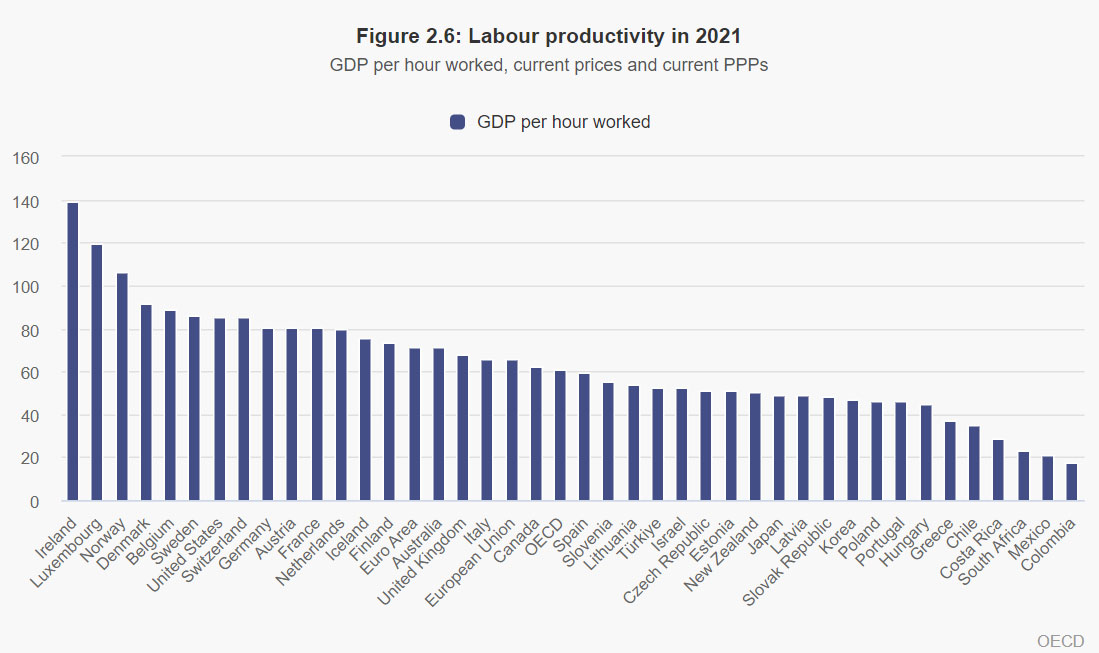Blog /
Policy Matters: Canada’s Productivity Problem
Policy Matters: Canada’s Productivity Problem
Productivity is an essential component of economic prosperity and linked to our standard of living.


Alongside inflation and interest rates, you probably noticed a lot of political conversations and media attention around Canada’s productivity in 2023. It’s an important topic because productivity is an essential component of economic prosperity and linked to our standard of living. Unfortunately, Canada’s productivity has decreased for 11 out of the past 12 quarters.

What is Productivity?
Productivity is measured by gross domestic product (GDP) created per hour worked. The more GDP created per hour, the higher the country’s productivity. According to OECD data for 2022, we produce $1.13 USD in GDP every minute. Compared to some of our fellow G7 nations, like France ($1.39), Germany ($1.45) and the United States ($1.50), or even the G7 average of $1.31, we certainly have room to improve.
Another way of looking at productivity is by inputs and outputs. Inputs are everything that a business needs to complete a task or create a product, and includes labour, equipment and supplies. An output is the result of the inputs, whether that’s a car, a software update or a kilogram of beef. A business’s productivity increases when it produces more or higher-value outputs with the same amount of inputs.
The adoption of remote work and the amazing potential of artificial intelligence were supposed to unlock a productivity boom, but the hype has yet to show up in the statistics. While Canada did experience a spike in productivity in the summer of 2020, we have since returned to 2016 levels.
Considering that we work more hours than in many other advanced economies, rank top in the G7 for people with college or university credentials, and lead in artificial intelligence innovation, our productivity should not be stagnant. So, what’s going on?

Barriers to Productivity
There are several factors that influence our poor productivity performance:
Skilled Labour Shortages
Shortages of qualified personnel can hinder productivity and right now Canada’s facing a growing demand for skilled workers across industries. This need is particular prevalent in fields requiring specialized skills, such as advanced manufacturing technologies, mining and agriculture.
Transportation of Goods
Canada is a large country and getting goods to and across provinces isn’t always easy for a couple of reasons: red tape that makes interprovincial trade difficult and frequent breakdowns in trade and transportation infrastructure because of extreme weather like floods, fires and snow, or weeks-long strikes. Such disruptions — preventable or not — interrupt the supply chain and increase the costs of goods.
Lack of Competition
Canada’s barriers to foreign competition are among the highest in comparison to other economically advanced countries. But without sufficient competition, companies with poor productivity are allowed to fill the market. In Canada, 5-7% of businesses qualify as zombie firms — businesses older than 10 years that would be insolvent if not for a constant infusion of new capital, often from the government. This business climate does not push our entrepreneurs to excel or our businesses to innovate.
High Proportion of Small Businesses
Canadian small and medium-sized enterprises (SMEs) are an integral part of our economy, accounting for 98% of all businesses. However, they are less productive than their counterparts in other countries and Canada’s larger companies. Why? Two significant reasons are a) a reliance on ineffective methods; and b) the slow adoption of technology and AI.
Ineffective Methods
Most SMEs continue to rely on less effective methods for improving productivity. A 2023 economic study by Desjardins found that commonly used tactics like increasing wages (82% use rate) and allowing greater flexibility with work hours (70% use rate) only have a success rate of 31% and 38% respectively. On the other hand, investing in automation has an 81% success rate but only a 33% use rate.
Slow Adoption of Technology
The same Desjardins study found that digitally mature SMEs grow faster and are more resilient. Yet, only 6% of Canadian businesses across industries plan to adopt AI in the next 12 months, according to the Business Data Lab’s 2023 Q1 Canadian Survey on Business Conditions Report.
While there are many organizations across industries making great strides in technology adoption, in general, sectors with a large share of SMEs, like agriculture and forestry, construction, and real estate, are among the least likely to adopt new technology.
- Only 3% of agriculture and forestry and construction businesses and 6% of real estate businesses plan to adopt AI.
- Only 3% of agriculture and forestry and real estate and 4% of construction businesses plan to move operations online.
- Only 3% of construction businesses and 4% of real estate businesses plan to automate tasks.
However, we can’t talk about SMEs without recognizing the productivity barriers they face too.
Regulatory Complexity
SMEs often face a complex regulatory environment that involves complying with federal, provincial, and municipal regulations. Navigating these regulations can be time-consuming and resource-intensive, leading to delays and increased costs.
Lack of Access to Capital
Access to affordable capital is essential for SMEs looking to invest in technology, research and development, and expansion. Challenges in securing funding can limit a company’s ability to innovate, which is related to productivity (we’ll talk about that more in How to Increase Canada’s Productivity).

The Relationship between Inflation and Productivity
Inflation (another hot topic in 2023 and of great concern to businesses and consumers alike) happens when:
- Demand for goods and services is greater than the supply.
- When the production or input costs increase but outputs do not.
In either scenario, the prices for goods and services increase for the consumer, causing them to experience a “loss of purchasing power”. When income doesn’t rise with the increase in costs, their standard of living suffers.
In Canada, wages have gone up substantially, but there hasn’t been a complementary boost in productivity. This forces businesses to either lay off staff or increase the cost of outputs, feeding into the cycle of inflation.

How to Increase Canada’s Productivity
Productivity is essential to our long-term standards of living, so it’s critical that we turn things around quickly. Enabling an innovative economy is one of the best ways we can improve Canada’s productivity. Here’s what that would involve:
Strengthening Investment in Agriculture
Agriculture is one of Canada’s most economically critical sectors. Government could help improve the sector’s productivity through innovation by partnering with businesses on research, product development and the commercialization of the agri-food sector, and developing policy supports to incentivize private sector research and development investment.
Increasing Digital, Technology and AI Adoption in Canadian Businesses
Most uses of AI in business won’t be mind-blowing — but they will improve efficiency by automating certain tasks and relieving some of the administrative duties from employees. In their Toronto Star op-ed, Catherine Fortin LeFaivre, Vice President, Strategic Policy & Global Partnerships, and Ulrike Bahr-Gedalia Senior Director, Digital Economy, Technology & Innovation at the Canadian Chamber of Commerce, wrote: “Imagine a residential construction company that uses AI to streamline hundreds of invoices from its trades and suppliers, giving employees more time to build homes while shedding administrative duties; or a business that uses AI for predictive maintenance of its vehicle fleet, ensuring a part is replaced before it leads to unplanned downtime and service delays.”
Invest in a Skilled Workforce
Part of increasing digital adoption is ensuring that Canada has a skilled and adaptable labour force capable of implementing and managing this new technology. Collaboration between the private sector and educational institutions and government to develop programs that train, upskill and reskill individuals will help address gaps in the workforce as will strategic, skills-based immigration programs aligned with regional labour needs and accelerating the process of recognizing foreign qualifications.
Supporting the Digital Transformation of SMEs
SMEs are often hesitant to invest in new technology due to a lack of technical skills and knowledge, challenges in hiring the skilled workers who could use this tech advantageously and difficulty getting financial support that would allow them to invest in innovation.
Government policy and supports for SMEs like the Canadian Digital Adoption Program’s Boost Your Business Technology grant are an integral part in helping SMEs overcome the barriers to adopting new technology and innovating their processes.
Streamlining the regulatory processes can help reduce the burden on SMEs, while clear and efficient regulatory frameworks can minimize compliance costs and administrative hurdles.
Ensuring Intellectual Property Protection
Intellectual property (IP) rights are a measure of innovation, which is linked to productivity since innovation is the significant improvement of a product, system, or process. And as mentioned before, improving productivity includes producing better, higher-quality outputs, not just more.
Yet, Canadian companies frequently transfer the patents for their inventions to foreign companies. As Daniel Schwanen, Vice President of Research at the C.D. Howe Institute, wrote in a 2021 letter to Ontario ministers, “…Canada is a research- and ideas-producing economy, that sees relatively few of the ideas generated here (or poaching those generated elsewhere) commercialized by Canadian firms.” As a result, the inventors don’t get the profits from their inventions.
Ensuring robust, reasonable, and reliable intellectual property protection for innovative products will give innovators the confidence to invest significant resources into R&D over many years, eventually paying into our productivity levels.
Increasing R&D Investment
Out of the G7 countries, Canada is second to last in terms of percentage of GDP spent on research and development. As written in a previous Policy Matters, investing in R&D is integral to equipping, attracting and retaining talent, and driving the innovation that allows Canada to stay competitive in a global market. Without sufficient investment in research and development, companies and countries face economic decline. Canada needs a research and development ecosystem that supports the talent and technology that can respond to urgent and emerging issues and areas of opportunity for economic growth.
We can’t change our productivity levels overnight, but it’s too important a factor in standard of living and our collective ability to pay for the things we want, including public services, to not prioritize.
Other Blogs

Protecting Mid-Market Businesses: Cybersecurity for Growing Enterprises

Policy Matters: Why It’s Time to Go All-In on Canada’s Economic Sovereignty





